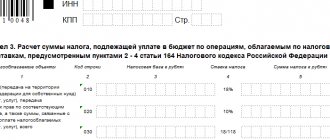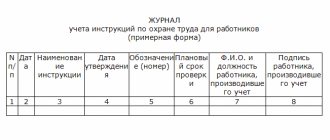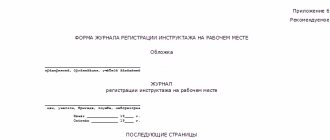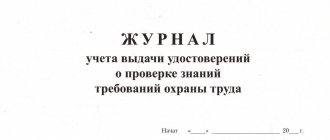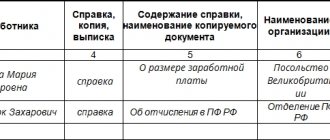Drawing up a log of completed work in the KS-6 form
The cost of performing the work is calculated in the prices specified in the contract.
The form of the log of completed work assumes the presence of several sections in which the following information is sequentially provided: a list of personnel directly involved in performing work at the site. This section is compiled by the head of the general contracting organization; list of all acts; a list of all work performed on elements and parts of buildings, the quality of their implementation is necessarily subject to control and evaluation; section to be filled out by the person responsible for the work; the main part of the journal, reflecting the beginning of work, its completion, as well as the progress of implementation.
The work performed is described according to the structural elements of the building.
It also provides brief information about the materials used in the work, production technologies, finished structures,
Form KS-6a “log book of work performed” (filling out)
So, let's start in order. Column 1. This indicates the serial number in this document of one or another type of work performed at the construction site; Column 2. The work position according to the estimate is entered here; Column 3.
Reflects the name of the type of work (it must be written in sufficient detail and clearly so that different interpretations cannot arise); Column 4.
Here you can put a dash (if the contract already states a clear cost of construction work); Column 5. The unit of measurement for the type of work is entered here.
For example, if this is paving a plot of land, then you can indicate square meters, etc.; Column 6. This includes the cost of performing a unit of work, for example, how much the same asphalting of one square meter will cost; Column 7. Number of works - how many sq.m. paved. Column 8 contains the estimated cost of the work.
Filling KS-6a
Further, the “Journal of completed work” KS-6a (table) contains data on the completion of work in the context of each month of the calendar year. The number of works performed and their cost are indicated monthly (in a separate column - the cost of work performed since the beginning of construction). Thus, three columns of data are filled in for each month.
Upon completion of the entire list of construction work scheduled for implementation within a specific facility, the log is subject to transfer to the supervisory authority.
Many legal entities and individual entrepreneurs working in the construction industry fill out both forms for reporting purposes, since in practice government agencies carrying out construction supervision can request either of them - there are no clear criteria for choosing a specific form of the general work log in the legislation.
Download samples Sample of filling out the KS-6a form Download The procedure for filling out the journal is established by the by-law of the State Committee of Statistics of the Russian Federation dated November 11, 1999 No. 100. The person responsible for maintaining and filling out the journal is an employee of the enterprise that has undertaken obligations to carry out the entire range of work at a construction site.
Not every uniform form is required
The question is, aren’t the unified forms approved by the State Statistics Committee of Russia generally binding?
Column No. 4 indicates units of measurement by type of work. For example, if this is laying a road with bitumen, then in this case you can indicate square meters. The question is important, let's figure it out. How a departmental act becomes normative Contrary to widespread belief, not all of the unified forms are mandatory for use. The fact is that decisions of the State Statistics Committee of Russia of an interdepartmental nature, which were not submitted for state registration to the Ministry of Justice of the Russian Federation (Ministry of Justice), are not considered normative legal acts. The requirements of such acts are not equivalent to mandatory state regulations intended for repeated use.
So, the Ministry of Justice did not consider all the decisions that introduced unified forms. Indeed, during the period of approval of resolutions containing unified forms, the State Statistics Committee of Russia was a federal executive body.
Publication rules
Logbook of work performed according to form KS-6a
The magazine itself consists of two parts: a title section, which includes information about the customer and the work contractor, and a table, which lists all the main parameters for materials spent, amounts and work performed.
Data on the organizations involved in the construction of the facility (customer, contractor) is entered on the first page of KS-6a. Here you must indicate their full name and contact information - address and telephone number.
Nearby, enter the OKPO codes in the appropriate cells (they are contained in state registration documents). Just below the name and location of the construction project are indicated.
Next, enter the date and number of the contract that served as the basis for the construction work, as well as the number of the document and the date it was completed.
Then you should enter the year during which this journal was filled out, as well as the contractual cost of the work performed under the contract (in numbers, there is no need to decipher the amount in writing).
All expenses associated with the construction of the facility are entered into the Logbook of Work Completed (Unified Form No. KS-6a (Approved by Resolution of the State Statistics Committee of Russia dated November 11, 1999 No. 100).
The log is kept by the contractor separately for each construction project based on uniform standards and prices for each structural element or type of work.
Then, based on it, the General Journal of Work Completed is filled out (Form No. KS-6).
General journal No. KS-6 is maintained throughout the entire period of work. The title page of the General Log of Work Completed is filled out before the start of construction by the general contracting construction organization with the participation of the design organization and the customer. When a completed construction facility is put into operation, the General Log of Work Completed is presented to the working commission and, after acceptance of the facility, is transferred for permanent storage to the customer or operating organization.
The general journal of work performed must be numbered, laced, signed by the manager and chief accountant, and also sealed with the organization’s seal.
The log book of work performed (form No. KS-6a) is the main primary document, which reflects the sequence, deadlines and conditions for construction and installation works.
Accounting for completed work is maintained by the contractor on a cumulative basis from the very beginning of construction until the full completion of the contractor's obligations for this construction project. In this case, the customer not only accepts the completed work, but can also control the order execution process. This journal is used to record work performed and is a cumulative document on the basis of which an Acceptance Certificate for Work Completed is drawn up in Form No. KS-2 and a Certificate of Cost of Work Performed and Expenses in Form No. KS-3.
In the Log Book of Work Completed (Form No. KS-6a), all work is distributed by month and the total amount for each type of work for the year is given, as well as the total cost of work for the year.
The unified form KS-6a is one of the main documents that is created to monitor the construction process, both from the management of the contracting organization, and from the customer and regulatory authorities. In other words, KS-6a is a special cumulative journal, a primary accounting document, which is drawn up after any type of construction and installation work is completed on any particular section of a construction site. It consistently reflects the stages, conditions and timing of certain construction works.
Ks 6 how and by whom it is filled out
The logbook for the work performed, in accordance with its name, is necessary to record the execution of construction and installation work.
It is the main primary document, which reflects the quality and timing of construction and installation work, their technological sequence and conditions of implementation.
Consultations and ordering services online: Send a request or The compilation of a log of completed work (KS-6) is carried out by the work contractor during the construction of buildings located on the same construction site.
Special construction organizations keep a special log of work, which is kept by the responsible persons. After the construction work is completed, this log must be handed over to the general contractor of the construction organization. Compiling a log of completed work is a fairly lengthy and diligent process.
Unified form KS-6 “general work log” + sample filling
This type of accounting documentation is a production log that records the progress of operations in construction, the timing of installation work, the quality of their implementation and authorized persons, as well as supervision of the progress of the process.
The journal is a legally registered document, so the person filling it out is legally responsible for the accuracy of the information entered. In the event of an emergency, the entries in this particular book are raised.
The main purpose of document formation is to monitor the progress of construction and repair work. With its help, records are kept of work performed and materials written off.
One log is kept on the territory of one construction base, even if it is a group of objects that are located nearby. Who fills it out and when? Most often, the document is maintained by the site manager or foreman.
Logbook of work performed according to form KS-6a
Brief information about the methods of work, the materials used, finished products and structures, forced downtime of construction machines (indicating the measures taken), testing of equipment, systems, networks and devices (testing idle or under load, power supply, tests on strength and tightness, etc.), deviations from working drawings (indicating the reasons) and their approval, changing the location of security, safety and signal fences, moving transport and fire passages, laying, relaying and dismantling temporary utility networks, the presence and implementation of operating diagrams quality control, corrections or alterations of work performed (indicating those responsible, as well as meteorological and other special conditions for the work).
Log book of work performed (ks-6a)
Who signs the journal at the enterprise The document (if filled out correctly) requires signing by the following persons:
- first manager (CEO);
- chief accountant of the contracting company.
Filling out the general journal of work KS-6 The form is presented with a title page and six sections, which consistently reflect:
- A list of names of persons involved in construction and installation work at the site, indicating the corresponding area of responsibility;
- Details of acts generated for the acceptance of intermediate stages of construction or installation work, including hidden work.
Procedure for filling out the general work log (sample)
Attention The unified form KS-6a is one of the main documents that is created to monitor the construction process, both from the management of the contractor, and from the customer and regulatory authorities.
In other words, KS-6a is a special cumulative journal, a primary accounting document, which is drawn up after any type of construction and installation work is completed on any particular section of a construction site.
It consistently reflects the stages, conditions and timing of certain construction works.
Who is filling out the KS-6a form? The registration of this journal is carried out by the responsible person on the part of the contracting organization, which is directly involved in the execution of construction and installation work. The log should begin to be filled out from the very moment the builders began to actually perform their duties.
Log books for completed work ks-6 and ks-6a
Based on the KS-6a form, a Certificate of Acceptance of Work Completed and Costs is subsequently drawn up (form KS-3). FILESDownload a blank form for the log book of work performed according to form KS-6a .doc filling out the log book of work performed according to form KS-6a.
doc Key points for filling out the KS-6a form To enter information into the journal, for each type of work, special measurements, norms and prices are first made.
The magazine itself consists of two parts: a title section, which includes information about the customer and the work contractor, and a table, which lists all the main parameters for materials spent, amounts and work performed.
https://youtu.be/SAObYDQcxnM
Form KS-6a - filling out the title page Data on the organizations involved in the construction of the facility (customer, contractor) are entered on the first page of KS-6a. Here you must indicate their full name and contact information - address and telephone number.
Why do you need a general work log, requirements for filling it out
Its title page is drawn up by the general contractor even before the actual work begins, with the involvement of the design organization and the customer. The cost of performing the work is calculated in the prices specified in the contract. The form of the log of completed work assumes the presence of several sections in which the following information is sequentially provided:
- list of personnel directly involved in performing work at the site. This section is compiled by the head of the general contracting organization;
- list of all acts;
- a list of all work performed on elements and parts of buildings, the quality of their implementation is necessarily subject to control and evaluation;
- section to be filled out by the person responsible for the work;
- the main part of the journal, reflecting the beginning of work, its completion, as well as the progress of implementation.
General work log (form No. ks-6)
- time frame of the information provided;
- the agreed price for the work performed at all stages;
- information about the person filling out the document, including his position and personal data;
- data of the employee who checked the information in the journal.
Information in the journal is entered into sections, according to calendar months. Particular attention is paid to the cost of construction and installation work at all stages.
This information is indicated on the basis of estimates and taking into account the requirements of specific methods for calculating the costs of this type of work.
Source: https://redtailer.ru/ks-6-kak-i-kem-zapolnyaetsya/
Filling out the table
The second part of the magazine concerns basic information on the construction project. So, let's start in order.
- Column 1. This indicates the serial number in this document of one or another type of work performed at the construction site;
- Column 2. The work position according to the estimate is entered here;
- Column 3. Reflects the name of the type of work (it must be written in sufficient detail and clearly so that different interpretations cannot arise);
- Column 4. You can put a dash here (if the contract already clearly states the cost of construction work);
- Column 5. The unit of measurement for the type of work is entered here. For example, if this is paving a plot of land, then you can indicate square meters, etc.;
- Column 6. This includes the cost of performing a unit of work, for example, how much the same asphalting of one square meter will cost;
- Column 7. Number of works - how many sq.m. paved.
- Column 8 contains the estimated cost of the work. This value is calculated by multiplying the indicators from the two previous columns (No. 6.7);
- Columns 9-44 contain the quantity and cost of work performed monthly, as well as the number of works performed since the beginning of construction at the time of a particular month (this figure is a cumulative total, which is the result of summation from the beginning of the year).
- Column 45. The total number of works for each type for the entire time is recorded here;
- Column 46. This includes the total cost of work for all months of the year;
It should be noted that all months are divided into three columns, and the necessary information must be entered into each of them.
It should be noted that all values from columns containing monetary values must be calculated and recorded in the final line “Total”, and if in any month according to the estimate there were no expenses or invoices, then the numbers in the “Total” column must be copied to column "Total". If there were overhead and other costs, they need to be added to the numbers in “Total” and this final total must be entered in the “Total” column.
The accounting journal in form KS-6a must be laced with a thick thread, numbered and sealed with the signature of the person responsible for filling it out and the seal of the company that issued it.
After the construction and installation work is completed, the general log must be handed over to the customer for storage. The second option is to give this document for storage to the operating company, which is subsequently responsible for the finished structure.
What is the KS-6 form (general work log)
Form No. KS-6 was approved by Decree of the State Statistics Committee of Russia dated October 30, 1997 No. 71a. It corresponds to number 0336001 according to OKUD. It is used to record the performance of various works related to construction and installation, and is one of the primary documents that record the technological sequence, quality level, conditions for the production of relevant types of work, as well as their timing.
The form in question is used when carrying out work within the same construction site, involving the construction, reconstruction or expansion of objects that can be combined into a group of the same type or considered as independent.
The general work log in the KS-6 form is kept by an authorized employee of the developer, customer or performer of work at the site, for example, a senior work producer or shift manager who is responsible for carrying out production work at the site.
The following can take part in the procedure for filling out the KS-6 form:
- developer representatives;
- customer representatives;
- employees of the organization developing design solutions.
Along with the KS-6 form, the Russian construction industry uses a document approved in Appendix No. 1 to Rostechnadzor Order No. 7 dated January 12, 2007 (this regulatory legal act was also assigned another number - RD-11-05-2007).
Many legal entities and individual entrepreneurs working in the construction industry fill out both forms for reporting purposes, since in practice government agencies carrying out construction supervision can request either of them - there are no clear criteria for choosing a specific form of the general work log in the legislation.
Read about the features of cost accounting during construction work in the material “Procedure for accounting costs in construction (nuances).”
General work log
14.02.2019 991
The general work log is form KS-6, the content and procedure for filling it out are established by Order of the Federal Service for Environmental, Technological and Nuclear Supervision dated January 12, 2007 No. 7 “On approval and implementation of the Procedure for maintaining a general and (or) special log of performance works during construction, reconstruction, major repairs of capital construction projects. RD-11-05-2007".
In this article we will try to answer the following questions in as much detail as possible, with examples and explanations: - where can I get the General Work Log or its forms; — how to correctly draw up and fill out the General Work Log; — which organization is responsible for filling out and maintaining this or that section of this journal; — what regulatory documents (in addition to Order No. 7 of January 12, 2007) should be followed when maintaining and filling out the General Work Log; — deadlines for entering data into certain sections of the journal.
For the convenience of our readers, we have created a special section - Answers to frequently asked questions.
A general work log can be purchased in specialized stores or printed out yourself. The second option is much more convenient - you can print exactly the number of pages in a certain section that your object requires. Download General work log: PDF, DOCX
The main document that you need to focus on when maintaining the General Work Log is the Town Planning Code of the Russian Federation (hereinafter referred to as the RF Civil Code). We recommend that you follow the amendments and updates that are added to it.
Basic terms
Developer (see clause 16 of Article 1 of the Civil Code of the Russian Federation) is an individual or legal entity that provides construction, reconstruction, major repairs of capital construction projects on a land plot owned by him or on a land plot of another right holder, as well as the performance of engineering surveys and the preparation of project documentation for their construction, reconstruction, overhaul.
Technical customer (see clause 22 of Article 1 of the Civil Code of the Russian Federation) is an individual acting on a professional basis, or a legal entity that is authorized by the developer and on behalf of the developer for the following types of activities: - concluding agreements on the performance of engineering surveys, on the preparation of project documentation , on construction, reconstruction, major repairs of capital construction projects; — preparation of tasks for performing the specified types of work; — provision to persons performing engineering surveys and (or) preparing project documentation, construction, reconstruction, major repairs of capital construction projects, materials and documents necessary to perform these types of work; — approval of design documentation; — signing the documents necessary to obtain permission to put a capital construction project into operation; — implementation of other functions provided for by the Civil Code of the Russian Federation.
The developer has the right to perform the functions of a technical customer independently. In this case, the person carrying out the listed activities is called the Customer.
A person carrying out construction (formerly a general contractor ) is an organization (or an individual acting on a professional basis), which, on the basis of an agreement with the Developer-Customer or Technical Customer, performs all work on the site (independently or with the involvement of third-party organizations, that is subcontractors).
In principle, a situation is possible when the Developer, the Customer and the person carrying out construction can be the same organization or individual.
A person carrying out construction (formerly a general contractor) is an organization (or an individual acting on a professional basis), which, on the basis of an agreement with the Developer-Customer or Technical Customer, performs all work on the site (independently or with the involvement of third-party organizations, that is, subcontractors ).
In principle, a situation is possible when the Developer, the Customer and the person carrying out construction can be the same organization or individual.
Architectural supervision – control over the compliance of construction work and materials with the provisions of the design, estimate and working documentation. Author's supervision is carried out by the organizations that developed this documentation. Architectural supervision is required during the construction of particularly dangerous, technically complex and unique objects (the full list is specified in Article 48.1 of the Civil Code of the Russian Federation). Please note that Federal Law No. 169-FZ dated November 17, 1995 establishes the right of the author of an architectural project not only to exercise architectural supervision, but also to demand from the customer the right to participate in the implementation of the project (primarily this applies to objects of cultural value). In addition, in accordance with clause 7.6 of the set of rules SP 48.13330.2011 “Construction organization. Updated version of SNiP 12-01-2004", approved by Order of the Ministry of Regional Development of Russia dated December 27, 2010 No. 781, the author's supervision of the architect is carried out by the author-architect on his own initiative, regardless of the decision of the developer (customer) and the existence of an agreement for author's supervision for the object. The territorial body for architecture and urban planning, at the request of the author, having verified his authorship, may issue an order to the developer (customer) to ensure the author's access to the construction site and the possibility of him making entries in the author's supervision journal. Claims of the author-architect regarding the implementation of architectural design solutions may be considered by the body for urban planning and architecture, the decision of which is binding on the developer (customer).
State examination of design documentation assessment of compliance of design documentation with the requirements of technical regulations, including sanitary and epidemiological, environmental requirements, requirements for state protection of cultural heritage sites, fire, industrial, nuclear, radiation and other safety requirements, as well as the results of engineering surveys, and assessment of compliance results of engineering surveys in accordance with the requirements of technical regulations. Detailed information about which bodies are authorized to conduct this examination, in which cases it is required and in which it is not, etc., is contained in Article 49 of the Civil Code of the Russian Federation.
State construction supervision - monitoring the compliance of the work and the building materials used during the construction, reconstruction of a capital construction project, as well as the results of such work with the requirements of technical regulations, design documentation, including energy efficiency requirements and the requirements for equipping a capital construction project with metering devices for the energy resources used . Carried out by authorized government organizations. Article 54 of the Civil Code of the Russian Federation contains detailed information about State construction supervision, objects for which it is mandatory, the grounds for its implementation, etc.
Construction control (formerly technical supervision) - is carried out during the construction, reconstruction, major repairs of capital construction projects in order to verify the compliance of the work performed with design documentation, the requirements of technical regulations, the results of engineering surveys, the requirements for construction, reconstruction of a capital construction project established on the date of issue submitted to obtain permission to construct an urban planning plan for a land plot, as well as the permitted use of the land plot and the restrictions established in accordance with land and other legislation of the Russian Federation. Construction control is carried out by the person carrying out the construction. In the case of construction, reconstruction, major repairs on the basis of a contract, construction control is also carried out by the developer or technical customer or an individual or legal entity engaged by them on the basis of a contract. The developer or technical customer, on his own initiative, may involve the person preparing the project documentation to verify the compliance of the work performed with the project documentation. More details can be found in Article 53 of the Civil Code of the Russian Federation.
The general work log should contain the following information: - data on all organizations/companies/individual entrepreneurs/individuals who carried out any expert, supervisory, control, etc. activities related to the object; — data on all organizations/companies/individual entrepreneurs/individuals related to the design of the facility; — data on all organizations/companies/individual entrepreneurs/individuals who took part in work at the site; — data on construction permits, examinations of design documentation, etc.; — data on all special work logs, briefings, knowledge tests and (if necessary) designer supervision logs, as well as a list of as-built documentation; — data on the timing and types of all work carried out at the site.
An example of filling out the General Work Log
Cover of the General Journal of Works. The cover indicates: - magazine number; — name of the organization responsible for its registration; — type of work — construction/major repairs/reconstruction, name of the object, its address/location. The cover is always filled out by the Developer.
Title page of the General Journal of Works. It consists of several (in our example five) pages. On the first page, the serial number of the journal, the name and address of the object are again indicated, then we fill in the items “Developer” and “Authorized representative of the Developer” (in the form under the lines of filling there are tips on what exactly to write). These items are always filled out by the Developer.
If the Developer is also the Customer (hereinafter in the text of the article Developer-Customer), then in paragraphs “Customer” and “Authorized Representative of the Customer” we simply repeat the information from the previous paragraphs. If the Developer and the Customer are different organizations, we recommend changing the names of the items, respectively, to “Technical Customer” and “Authorized Representative of the Technical Customer” to reduce confusion.
Let's move on to the second page. The first item is “Information about the issued construction permit.” In Art. 51 of the Civil Code of the Russian Federation contains all the information about what documents need to be collected to obtain a construction permit, who issues it, the validity period of the permit, etc.
Briefly, the procedure for obtaining a building permit looks like this. Project documentation, engineering and architectural diagrams necessary to obtain a permit are collected by the Developer-Customer or Technical Customer. These documents, together with the Developer's certificate of ownership, are submitted to the authorized bodies by the Developer/Builder-Customer, who also receives a construction permit.
Accordingly, this item on the title page is filled out by the Developer or the Developer-Customer.
The following paragraphs are “The person preparing the project documentation” (hereinafter referred to as the Design Organization/Design Organizations), “Authorized representative of the person preparing the project documentation on issues of compliance of the work performed with the design documentation (hereinafter referred to as Author’s supervision)” and “Information on the state examination of design documentation." They are filled out by the Developer-Customer or Technical Customer.
Let's take a closer look at the following points. In the “Project organization” item there is a line “Information about sections of project documentation”. This includes the section numbers prepared by this design organization. The procedure for maintaining sections of project documentation (there are 12 in total) is determined by Decree of the Government of the Russian Federation dated 02/16/2008 N 87 (as amended on 04/28/2017) “On the composition of sections of project documentation and requirements for their content”, it also indicates the numbers and names of these sections . If the entire project is completely prepared by one organization, then in this paragraph you can indicate “Sections 1 – 12”. If project documentation is prepared by several organizations, it is better to add additional empty lines to the “Project organization” item; for each organization, enter the numbers of sections of the project documentation prepared by it. For example: Drawer LLC - section 4, Designer LLC - sections 1-3, 5-12. If Author's supervision is required, the next paragraph indicates the authorized representative of the design organization who will carry it out. Accordingly, if the project was prepared by more than one organization, representatives of all design organizations must be indicated in this paragraph. If Author's supervision is not required, this item does not need to be filled out.
Let's move on to the next point. If State examination of project documentation is required, the number, date of receipt of the conclusion and the name of the organization that issued it are entered here. This item is filled out by the Developer.
Next come the items “Person carrying out construction” and “Authorized representative of the person carrying out construction”. Here, the Developer-Customer or Technical Customer enters data about the organization that performs all work on the site with its own or attracted forces and those employees of this organization who are responsible for this facility.
The following paragraphs concern authorized representatives of the Developer-Customer or Technical Customer and the Person carrying out construction on issues of Construction Control (formerly Technical Supervision). If the Developer-Customer (or Technical Customer) and the person carrying out construction are the same organization/individual, then only the item “Authorized representative of the person carrying out construction” is filled in. If these are different organizations/individuals, then the Developer-Customer (or Technical Customer) must also exercise construction control and appoint his authorized representative.
Next comes the item “Other persons carrying out construction”. This includes information about all companies and individuals who performed any work at the site (i.e., subcontractors). This item on the title page is maintained by the person carrying out the construction, since it is this organization that either carries out all the work itself or hires subcontractors. We recommend that you print out more pages for this item on the title page, since there are often a very large number of contractors working on site.
Let's move on to the last page of the title page.
The first point is information about State Construction Supervision (if required). This item is filled out directly by a representative of the State Construction Supervision.
Next, the Developer enters General information about the object - name, brief design characteristics, start and end dates of work. Please note that in the example we are considering a capital construction project, if the work is related to reconstruction or major repairs, this should be noted.
After this, the number of pages in the magazine is indicated, the Developer’s seal, the position and signature of the legal or authorized representative of the Developer are affixed. The item “Registration note of the state construction supervision body” is filled out, as indicated in the journal itself, by a representative of the state construction supervision, and they are also assigned a registration number. The journal is submitted for registration by the Developer-Customer or Technical Customer.
The last item is “Information about changes in Title Page entries.” Here, for example, the replacement of one of the responsible persons, changes in details, etc. can be noted. This item is filled in by the Developer.
A general work log with a completed title page, registered with the State Construction Supervision authorities, is transferred for maintenance to the person carrying out the construction and must remain at the construction site until the completion of the work.
It is possible that one or more sections of the bound magazine run out of pages. In this case, the maintenance of this copy of the journal is terminated; the end date of maintenance is indicated in the corresponding paragraph of the title page. The developer starts a new journal with the next serial number and transfers it to the site, and the completed journal is stored at the site.
After completion of all work on site and passing the final inspection, the General Work Log is transferred to the Developer for permanent storage.
Sections of the General Work Log.
Sections 1,2,3,5 and 6 are completed by authorized representatives of the Person carrying out the construction. Section 4 is completed by an authorized representative of the Developer-Customer or Technical Customer. Section 7 is completed by an authorized representative of the State Construction Supervision.
Section 1. List of engineering and technical personnel involved in construction, reconstruction, and major repairs. Representatives of all organizations conducting work at the site are listed here.
Section 2. List of special logs of work and designer's supervision Here, accordingly, all logs are noted, indicating which particular contractor or design organization kept them. Special logs must be kept at the site until its commissioning, and then stored by the Developer along with the General Work Log. An important point is that for each type of work and for each organization its own special journal is created. That is, even if welding work at the site was carried out by ten different companies/individuals, ten welding work logs are required - separate for each contractor. If one company performed several types of work (for example, welding, excavating a pit and driving reinforced concrete piles), then a separate log is kept for each type of work.
Section 3. Information on the execution of work Information about all work performed at the site on that day is entered here daily. Even if a certain type of work was carried out within a month, it is necessary to note on a daily basis in what area, what volume of work and using what materials was completed today.
Section 4. Information on construction control of the Developer-Customer or Technical Customer
Section 5. Information on construction control of the person carrying out the construction. Data on identified deficiencies, for example, non-conformity of materials or quality of work, are entered in these sections. An important point is that a deadline must be set for eliminating the defect (“Immediately”, “By 04/08/2017”, etc.). It is also necessary to ensure that the identified shortcomings are either eliminated by the specified deadline, or an objective reason is indicated why this period was extended. If no defects were identified during construction inspection, it is advisable to reflect this in the log so as not to create the impression that control is not being carried out at all. The correctness of maintaining these sections is often paid attention to during State Construction Control and Author's Supervision.
Section 6. List of as-built documentation This includes, for example, acts of acceptance and transfer of work and acts of inspection of hidden work. If the Act of Hidden Work No. 2 is accepted by the same persons as the Act of Hidden Work No. 1, then you do not have to enter them again, but put a repeat sign.
Section 7. Information about State Construction Supervision This section notes the results of inspections by Gosstroynadzor. Please note that they can check not only the compliance of work and materials with project documentation, but also the correctness of the design and maintenance of all logs.
Please note that only an authorized representative of the Person carrying out the construction can make entries in sections 3 and 6 (Information on the execution of work and the List of as-built documentation).
We hope you found this article helpful.
If you still have any questions, you can refer to the Frequently Asked Questions section.
Download the General Work Log for free: PDF, DOCX
Share this article:
Form RD-11-05-2007 as an alternative to the KS-6 journal
Order No. 7 of Rostechnadzor dated January 12, 2007 establishes, first of all, the procedure in accordance with which the general work log should be kept. This order was issued in order to implement the provisions of Art. 54 of the Town Planning Code of the Russian Federation, as well as sub. “b” clause 13 of the Regulations on state construction supervision, approved by Decree of the Government of the Russian Federation dated 01.02.2006 No. 54.
The general work log, in accordance with the provisions of the order RD-11-05-2007, is a source in which:
- records are kept of all work related to construction, reconstruction, and major repairs;
- the sequence of performance of the relevant work is reflected;
- the terms and conditions of work are indicated;
- information on control and supervision carried out by government agencies is recorded.
The general work log in the form RD-11-05-2007 must be submitted no later than 7 days before the actual start of work to the state body carrying out the construction supervision procedure in cases provided for by the provisions of paragraph 1 of Art. 54 of the Town Planning Code of the Russian Federation. Along with the journal, this body is provided with:
- a copy of the construction permit;
- design solutions;
- a copy of the document confirming the placement of so-called red lines on the area;
- work logs classified as special;
- conclusion of an examination of design solutions, if one is required, based on the provisions of Art. 49 of the Code.
The state body carrying out construction supervision seals this journal, as well as special journals, puts a registration signature on them and returns the corresponding package of documents to the developer or customer so that they can keep records of the work. If the current journal ends, then a new copy must be registered with the construction supervision authority, on which a mark with the number - 1, 2, etc. must be affixed.
Completed logs in form RD-11-05-2007 must be kept by the developer or customer until the completion of the final inspection carried out by the construction supervision authority. During the period of such inspection, the journal is at the disposal of the relevant regulatory authority.
What is a journal of work performed in form KS-6a?
Form KS-6a was approved by Decree of the State Statistics Committee of the Russian Federation dated November 11, 1999 No. 100. It corresponds to number 0322006 according to OKUD.
The logbook for the work performed in the KS-6a form must be kept by the work performer, using:
- data on measurements of completed work at construction sites;
- information on uniform standards and prices relating to structural elements or types of work.
Based on the information contained in this journal, the following are compiled:
- acceptance certificate - in form KS-2;
- certificate of cost of work - in form KS-3.
You can learn more about forms No. KS-2 and KS-3 and see examples of filling them out in the articles:
- ;
- “Unified form No. KS-3 - form and sample.”
But why is the KS-6a form needed if information about work on construction sites is recorded in the KS-6 or RD-11-05-2007 journal?
The main difference between this journal form and the previous ones is that information on work is always entered into it for each property separately. While forms KS-6 and RD-11-05-2007 allow the inclusion of information on the construction site as a whole.
Who fills it out and when?
Most often, the document is maintained by the site manager or foreman .
The person who is solely responsible for the maintenance and authenticity of the records is indicated on the very first sheet. Documentation begins from the first day of work. All important information is entered into the log by general contractors. They are required to record each type of activity: installation, pouring, laying, etc.
The document may be requested during the process by any regulatory authorities. Therefore, it is always in the stage of active filling. The journal has a unified form No. KS-6 , which was approved back in October 1997 in a resolution of the State Statistics Committee. Available in A4 format.
Are journals KS-6, KS-6a and RD-11-05-2007 required to record work performed?
Information from the Ministry of Finance of the Russian Federation dated December 4, 2012 No. PZ-10/2012 contains the department’s opinion with reference to the new law dated December 6, 2011 No. 402-FZ that it is not necessary to use unified forms of primary documentation from 2013.
These forms, on the one hand, include forms KS-6 and KS-6a. On the other hand, there are no criteria that allow us to classify the RD-11-05-2007 form as unified. What document, then, should Russian builders use to record work?
In this case, it is legitimate to talk about the need for a correct comparison of legal norms and law enforcement practice.
As for the first aspect, the provisions of sub. “b” clause 13 of the Decree of the Government of the Russian Federation dated 01.02.2006 No. 54 instructs construction supervision authorities to somehow check the availability of a general work log. On the one hand, the legislator does not specify its form, on the other hand, in the same subsection. “b” clause 13 of Resolution No. 54 introduces a rule according to which the procedure for maintaining the relevant journal is established by Rostechnadzor. Since this department issued document RD-11-05-2007, we can conclude that the form of the construction work log should, first of all, correspond to that approved in RD-11-05-2007.
However, as practice shows, in many regions of the Russian Federation, construction supervision authorities, due to the established legal tradition, require keeping a log in the KS-6 form. Sometimes both forms are requested at once.
Moreover, among lawyers there is a widespread point of view according to which form No. KS-6a is primary in relation to other journals, even in cases where the real estate object is the only one on the site. Since it is not necessary to use unified forms, the construction supervision authority may well request it (or a similar one).
Thus, in practice, it may be necessary to provide the construction supervision authority with all 3 documents we considered:
- form KS-6;
- form KS-6a;
- form RD-11-05-2007.
It all depends on the policies of regional government structures that supervise the construction sector. But very often the state limits itself to requesting a document approved in accordance with RD-11-05-2007 - perhaps due to the fact that the need to fill it out becomes obvious upon a literal reading of the provisions of Government Resolution No. 54 dated 01.02.2006.
For information on how labor protection is carried out during construction work, read the material “Rules on labor protection in construction in 2017.”
Sample of filling out the general work log according to form KS-6
On the title page of the KS-6 journal we record:
- name of the organization carrying out construction work, its address, OKPO;
- description of the object (for example, “monolithic residential building with underground parking”), its address;
- Full name, position of the representative of the legal entity responsible for the construction of the building, as well as for maintaining the journal;
- name of the design organization, full name, position of its representative;
- name of the customer, if it is a legal entity - position, full name of the representative;
- the start and end dates of work - according to the contract or actually (if they coincide, then we write only the terms under the contract);
- number of pages in the magazine (it must be bound and numbered);
- Full name, position of the head of the company that issued the magazine;
- key characteristics of the building, cost of work in words and figures (for example, “20-story residential building with a parking lot for 100 parking spaces. The cost of work is 30,000,000 (thirty million) rubles. 00 kopecks.”);
- name of the approving authority and date of approval of the construction project (for example, “Department of the Smolensk Region for Architecture and Construction”, 02/17/2017);
- name of subcontractor organizations - if any are involved in the implementation of the project;
- The name of the organization that developed the project documentation must match that indicated above.
Filling out sections of the KS-6 form
A sample of filling out the KS-6 form can be downloaded from our website:
Section 1 states:
- Full name, positions of the company employees performing the work, as well as the areas in which they work (for example, “Andreev S.V., foreman, installation of building structures”);
- start and end dates of work performed by a specific employee;
- information about the document confirming the employee’s qualifications (for example, “Engineer Qualification Certificate No. 111 222, issued on December 10, 2016”).
To learn about the professional requirements for construction workers, read the article “Professional Standards in Construction.”
Section 2 reflects:
- names of various acts related to construction (for example, “Act on the assembly of building structures”, “Act on approval of the technical report and drawings”);
- dates of signing of the relevant acts, full names and positions of the employees who signed them.
For each act, a serial number is recorded.
Section 3 states:
- dates of activities for monitoring and assessing the quality of work;
- names of structural parts of buildings, indication of their location, links to the numbers of the corresponding drawings (for example, “Pit, drawing No. 20 dated 08/20/2016”);
- control results (for example, “The pit corresponds to the drawing, there are no complaints”);
- names of the companies that carried out the inspection, full names and positions of the inspection specialists.
In section 4 it is necessary to record:
- names and dates of issue of special journals used during the implementation of the construction project (for example, “Journal for conducting engineering tests, 04/15/2017”);
- names of companies maintaining relevant journals, full names and positions of employees responsible for maintaining these documents;
- dates of delivery and acceptance of special journals, signatures of the general director of the contractor organization.
Section 5 provides:
- start and completion dates of work - in one column (for example, “05/01/2017–05/17/2017”);
- description of the work, conditions for its implementation, full name and position of the responsible persons (for example, “Installation of construction equipment, responsible: foreman Andreev S.V.”);
- position and signatures of the employee responsible for working with the magazine.
For information on the document used to formalize the acceptance of completed construction work, read the material “Acceptance Certificate of Completed Construction Work - Sample.”
Section 6 is completed by employees of government agencies. They record:
- date of inspection;
- comments, full names, positions of inspectors;
- notes indicating that the comments were accepted for implementation, and checking that the reasons that caused them have been eliminated.
On the last page of form No. KS-6 after section 6 the following is indicated:
- number of sheets in the document;
- Full name, position, signature of the person in charge, seal;
- date of signing of the journal.
What is included in the basic sections of general work logs
In the general journal SNiP 12-01-2004, Section 2 contains a list of special documentation that takes into account the implementation of construction and installation work and provides a list of documents of designer supervision of the person responsible for the preparation of project documentation. The third section contains a list of acts on the interim acceptance of work in chronological order, and the fourth section contains information about the control of the construction process on behalf of the developer. The fifth section is used to record comments from regulatory authorities.
- In the KS-6 document, the second section lists acts of intermediate acceptance of building structures and the results of the examination of “hidden” operations. The 3rd section includes a statement of the report on the results of operational control and the results of assessing the quality of work, and the fourth section contains a list of work on parts and structural elements of buildings. The 5th section provides information on production and the exact time of the start and end of repair and construction work, and the sixth contains comments from the regulatory services.
- The 2nd section of the journal RD 11-05-20078.1 provides information about repair and construction work, their start and completion dates, and describes the procedure for their implementation. The 3rd section indicates the methods and construction materials used, the fourth section lists the construction workers. The fifth section is reserved for information about your own supervision, and the 6th and 7th sections are for the list of construction documents, acts, examinations, construction supervision, etc.
Confusion occurs when choosing between general journals and a regular work production journal. The first cover the full list of work in production, and the second is carried out for each individual area of activity - drilling, general construction, mining and other work. The last document lists the working personnel and makes comments from supervisory authorities, which are not in the general journal. In most situations, work logs complement, but do not replace, general logs.
Is it difficult to choose a suitable magazine for organizing construction, repair or restoration work? Contact us: Bitrade specialists will offer the necessary documentation and also place an order for any batch of goods with delivery in Moscow, Moscow Region and other regions of the Russian Federation. To view the full list of magazines, go to the main catalog of the online store.
Form RD-11-05-2007 as an example of filling out a general work log
You can download a completed sample of the specified form RD-11-05-2007 on our website:
The main differences in filling out the title page of the form in question and the previous one in terms of filling out the title page:
- in the form RD-11-05-2007 it is assumed to indicate the name of the developer, the customer and the organization that actually carries out the construction;
- in the form RD-11-05-2007 it is expected to indicate the persons responsible for construction control - from the customer or developer or from the company that carries out the construction;
- in the form RD-11-05-2007, the state supervisory authority puts marks on the title page.
The main differences between the form RD-11-05-2007 and KS-6 in terms of filling out section 1:
- the name of the company carrying out the construction is indicated;
- Full name is indicated. and the position of a representative of the construction company;
- information about the document confirming the employee’s qualifications is not indicated.
Regarding section 2 of the general work log:
- this section of the RD-11-05-2007 form coincides in purpose with section 4 in the KS-6 form;
- The information indicated in the section is certified by the signature of a representative of the developer or the customer.
Regarding Section 3
- this section coincides in purpose with section 5 in the KS-6 form;
- the position and full name are indicated. representative of the company that carries out the construction.
As for sections 4 and 5, section 3 in form KS-6 corresponds to those in purpose, however, the structure of sections in form RD-11-05-2007 differs significantly from that in form No. KS-6. Thus, in sections 4 and 5 of the form under consideration the following is recorded:
- serial number of the control activity;
- control data;
- information about identified deficiencies, the deadline and date for their elimination;
- Full name, position of representative of the developer or customer.
Besides:
- the information in section 4 is certified by the signature of a representative of the developer or customer;
- the information in section 5 is certified by the signature of a representative of the company carrying out the construction.
Section 6 of the general work log in form RD-11-05-2007 generally corresponds in structure and purpose to section 2 in form KS-6.
Section 7 corresponds in purpose to section 6 in the KS-6 form. Main differences:
- the form RD-11-05-2007 records the period and date for eliminating the violations identified during the supervisory inspection;
- The number of the event is recorded in order.
What is similar in general construction work logs?
Maintenance goals . The sections of general journals reflect the order and timing of construction and repair work, reconstructions and contain information about inspections by state regulatory authorities. The production log has a narrow specialization - it is filled out for one class of work: installation and welding, excavation, laying utilities or others. This documentation describes the technological sequence, conditions, timing and quality of construction and installation operations.
Principles of filling and storage. The documentation is completed by authorized representatives of the developer. The pages of the document are numbered, stitched and sealed. In construction supervision, they put a serial number on the magazine and make a registration inscription.
Contents of Section I. A detailed list of engineering and technical employees from the developer and contractor representatives is posted here.


